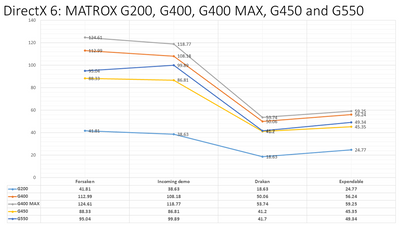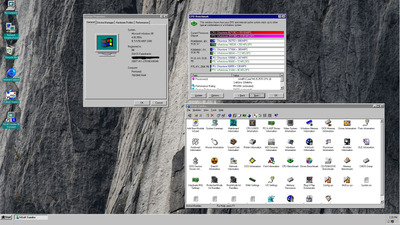First post, by fosterwj03
I’ve been experimenting with a number of video cards lately, and it got me thinking about which card works or performs best with each OS I test. So, I thought I’d share my opinions as well as ask the community to share theirs.
Feel free to offer you thoughts based on any objective criteria like performance and quality as well as subjective criteria like your personal preferences. Please add your reasoning for each nomination.
You can also offer thoughts on other operating systems than the ones I mention. I’m a little biased toward PC operating systems (mostly Windows and OS/2).
I’m also a little biased toward PCI and PCIe cards due to the platforms I use for tests. You can also address other architectures or families as you see fit.
Here’s my take so far:
Windows 2.x – IBM 8514/A or Clone (Such as the ATI Graphics Ultra Pro [PCI, Mach32, 2MB])
Pros: High resolutions (1024x768) and color depth (256-color); native OS driver support
Cons: Limited resolution options; lack of software to utilize the capability
OS/2 1.x – ATI Graphics Ultra Pro (PCI, Mach32, 2MB)
Pros: Very high resolutions (1280x1024) and high color depth (256-color); native manufacturer driver support; backward compatible with 8514/A and VGA drivers
Cons: Lack of software to utilize the capability
Windows 3.0 – Cirrus Logic CL-GD5446 (PCI, 2MB)
Pros: Very high resolutions (1280x1024) and color depths (16M colors); backward compatible with VLB drivers; excellent 2D performance
Cons: Poor 256-color palette swaps; poor color reproduction in 256-colors
Windows 3.1x – Matrox G200 (PCI, 8MB) or G400 (AGP, 16MB)
Pros: Software programable RAMDAC for custom resolutions and refresh rates; support for digital flat panels; native manufacturer driver support; excellent 2D performance; excellent 2D image quality
Cons: Limited to 4x3 or 5x4 aspect ratios
OS/2 2.x – Matrox Millennium (PCI, 2MB)
Pros: Software programable RAMDAC for custom resolutions and refresh rates (including 1080p); WRAM upgradable to 8MB (allows higher resolutions and color depths); native manufacturer driver support; excellent 2D performance; excellent 2D image quality; support for seamless Windows
Cons: None
Windows NT 3.1 – Matrox Impression+ or Compaq QVision 2000+ (PCI, MGA-Athena, 2MB)
Pros: Software programable RAMDAC for custom resolutions and refresh rates; VRAM upgradable to 4MB (allows higher resolutions and color depths); native manufacturer driver support; excellent 2D performance; excellent 2D image quality
Cons: Limited to 4x3 or 5x4 aspect ratios
OS/2 Warp 3 and 4 – Matrox G550 (PCIe x1, 32MB)
Pros: Software programable RAMDAC for custom resolutions and refresh rates (including 1080p); support for digital flat panels; backward compatible with PCI/AGP drivers; excellent 2D performance; excellent 2D image quality; support for seamless Windows
Cons: None
Windows NT 3.51 – Matrox G200 (PCI, 8MB) or G400 (AGP, 16MB)
Pros: Software programable RAMDAC for custom resolutions and refresh rates (including 1080p); support for digital flat panels; native manufacturer driver support; excellent 2D performance; excellent 2D image quality
Cons: Little to no OpenGL support
Windows 95 – Nvidia GeForce 6800 (PCIe, 256MB)
Pros: Very high resolutions (including 1080p) and color depths; support for digital flat panels; backward compatible with AGP drivers; excellent 2D performance; excellent 2D image quality; excellent DirectX 7 and 8 performance
Cons: Buggy drivers; last drivers intended for Windows 98 (causes .DLL errors); poor DirectX 5 and below performance; requires additional memory management or patches to support 256M of VRAM; loud fan
Windows NT 4.0 – Nvidia GeForce 6800 (PCIe, 256MB)
Pros: Very high resolutions (including 1080p) and color depths; support for digital flat panels; backward compatible with AGP drivers; excellent 2D performance; excellent 2D image quality
Cons: Poor DirectX 5 and below performance; loud fan
Windows 98 – ATI Radeon x800 or x850 (PCIe, 256MB)
Pros: Very high resolutions (including 1080p) and color depths; support for digital flat panels; native manufacturer driver support; excellent 2D performance; excellent 2D image quality; excellent DirectX performance
Cons: Requires additional memory management or patches to support 256M of VRAM; loud fan
Windows 2000 (Shipped Kernel) - ATI Radeon x1900 or x1950 (PCIe, 256MB)
Pros: Very high resolutions (including 1080p) and color depths; support for digital flat panels; native manufacturer driver support; excellent 2D performance; excellent 2D image quality; excellent DirectX performance
Cons: Loud fan

